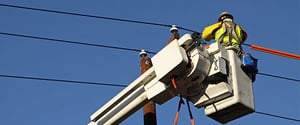Digging into the FCC's Third Report and Order & One Touch Make Ready
 Professionals in the joint use industry are preparing for compliance under the FCC’s Third Report and Order. The FCC’s policy features a new pole attachment process with specific timelines that pole owners, existing attachers, and new attachers must follow. One Touch Make Ready is a part of this new process, and will likely require new processes and internal job role transitions.
Professionals in the joint use industry are preparing for compliance under the FCC’s Third Report and Order. The FCC’s policy features a new pole attachment process with specific timelines that pole owners, existing attachers, and new attachers must follow. One Touch Make Ready is a part of this new process, and will likely require new processes and internal job role transitions.
The Report and Order lists several new processes and timelines for joint use parties. It includes two paths for deployment: One Touch Make Ready and a self-help route for new attachers. It also permits overlashing, simply asking the attacher to notify the owner. Pole owners cannot require prior approval for overlashing.
Why One Touch Make Ready (OTMR)?
The Third Report and Order establishes a variety of new requirements that the joint use community must meet. The joint use community includes asset owners, attachers, contractors, third parties, and other professionals who handle anything regarding jointly used assets. The FCC states that the new requirements outlined in the Order will replace ambiguous guidelines with more specific guidelines.
It is important that joint use parties understand that One Touch Make Ready rules apply only to simple attachments in the middle (“communications space”) of a utility pole. Attachers at the top (or “electric space”) of the pole must follow a multi-touch process. Further, the new outlines in the Report and Order only apply to FCC-regulated States. Self-governing States will want to pay attention to the new rules, in the case that parts of their business work with joint use teams who have assets in FCC-regulated States.
What Will Change Under the New Policy?
With that said, the second big change brought on by OTMR is new timelines. In the Report and Order, there are new timelines for each phase of the pole attachment process. Timelines must be met to be FCC complaint. Joint use professionals should adapt a specific process for adhering to these timelines. With the new timeline changes come notice changes. For each step of the timeline, a notice must be sent to the corresponding party. The Third Report and Order requires that notices be sent out for almost every part of the process. Both owners and attaching companies are required to alert the other of any and all field work.
What Does OTMR Mean for You?
At Alden, we’re hearing wide-ranging questions from owners, attachers and contractors about OTMR. Some questions we've heard include: Where do I get started? and Does this effect my business? to How do I implement the new processes? You can hear several answers to these questions by listening to our OTMR webinar: How to Get Compliant with One Touch Make Ready.Otherwise, companies can transition to OTMR timelines and policies by taking a few simple steps.
For asset owners, the first step is to update your contacts. Knowing who to contact and when, as well as having current contact information easily accessible, will make the OTMR process run much more smoothly. Additionally, cultivating a list of qualifications for contractors (based on the OTMR guidelines) is especially important. From there, building a list of approved construction contractors who are qualified to work on assets will help streamline the new processes.
For attachers, the first step is to become familiar with the authorized-contractor list of requirements and to reach out to local asset owners for their lists. Once they are ready to move forward, building an internal process for the new timelines and notice requirements is essential.
We recommend, for all parties involved, centralizing all asset data. Many companies have joint use teams who are already stressed with repetitive data entry and using multiple systems to complete a single joint use process. With these repetitive and time-consuming practices in place, jumping into the OTMR change is making joint use departments feel stressed.
Fortunately, there are alternative solutions and processes to stress, multiple systems, and manual data entry. Companies can have an efficient transition to OTMR by getting started the right way.
Alden Can Help with OTMR
Our goal is to help owners and attachers save their energy, time, and budget during this complex new process. If you are struggling with where to begin or how to put compliant processes in place, reach out to one of our specialists to discuss how a joint use platform can help your company transition to OTMR. Aside from our platform, we offer consulting services that help companies put an actionable plan together.
Our team is here to walk with you through every step, click below to learn more about One Touch Make Ready compliance.
